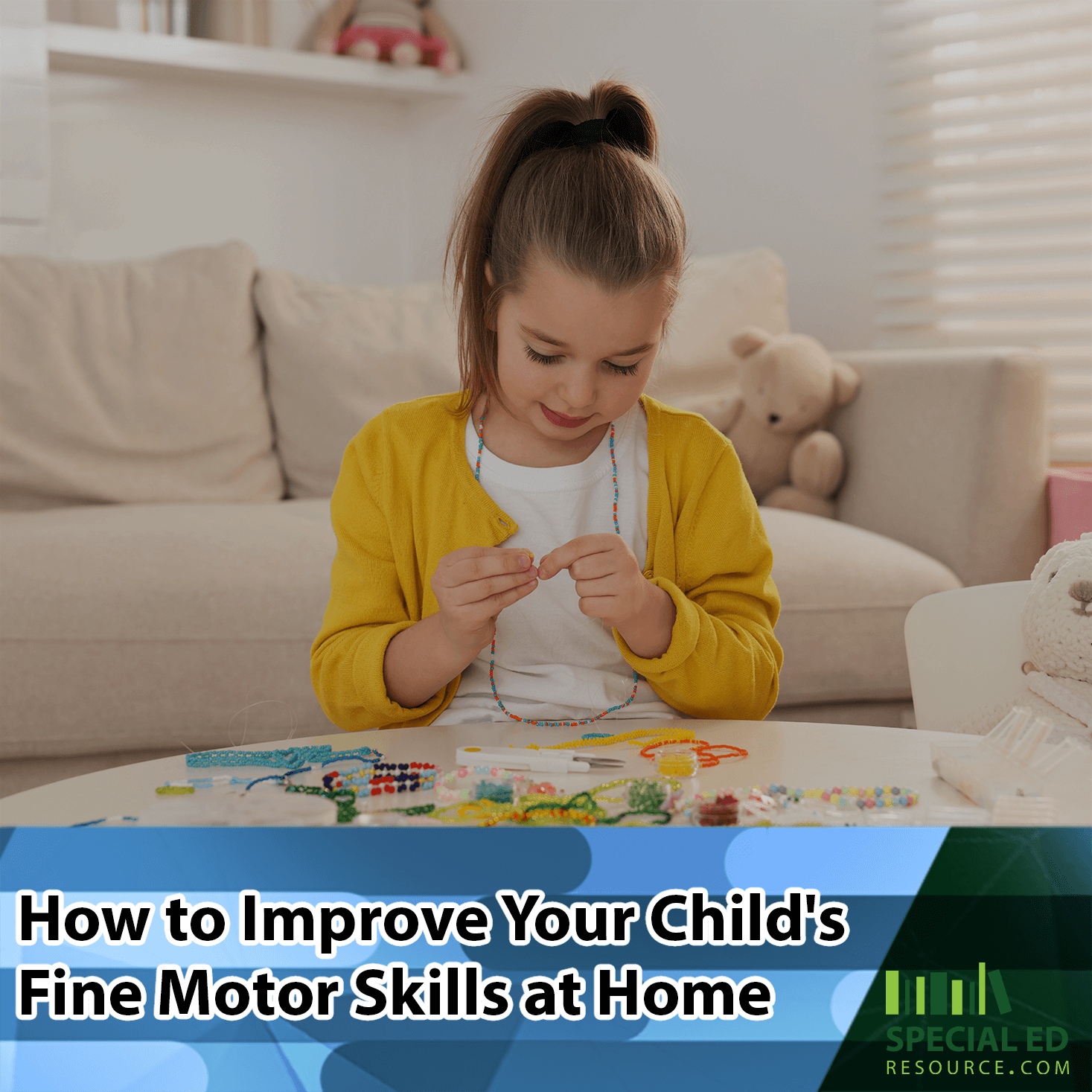Sam’s parents were growing concerned about his struggles with everyday tasks that used fine motor skills. He had difficulty tying his shoelaces, even though most children his age had mastered this task. Even buttoning his shirt or using a pair of scissors seemed more challenging for him than his peers.
After discussing the situation with his teacher, Sam’s parents decided to look for simple ways to help him at home. They dove into research, sought advice, and started incorporating fun activities to improve Sam’s poor fine motor skills into their daily routine.
The transformation they saw in Sam was incredible! He started gaining confidence as he began independently handling tasks he once struggled with. And his academic performance at school increased.
These skills impact the ability to carry out day-to-day activities and play a substantial role in academic achievement. In particular, activities focusing on fine motor skill development can be highly beneficial, encouraging young children to engage, explore, and, most importantly, learn while having fun.
Whether your child faces challenges similar to Sam’s or you’re simply seeking the best way to enhance their motor skills further, this article will provide fun but simple activities you can implement at home.
The goal is to empower parents and caregivers to provide an enriching and supportive environment, enabling every child to excel at their own pace.
Fine Motor Skills vs. Gross Motor Skills
Before diving into the strategies and activities to improve your child’s fine motor skills, we must understand what we mean by ‘fine motor skills’ and how they differ from ‘gross motor skills.’
What are Fine Motor Skills?
Fine motor skills require the coordination of small muscles, usually those in our hands, fingers, and wrists, along with our eyes. It is often called hand-eye coordination. These skills allow us to perform tasks that require precision and control with small movements.
What are Gross Motor Skills?
Gross motor skills require the larger, stronger muscle groups of our bodies. These skills allow us to perform physical activities that require power, balance, and coordination, such as walking, jumping, or throwing a ball.
While both types are important skills for your child’s development, our focus today is on the development of fine motor skills.
Examples of Fine Motor Skills Activities
– Buttoning or zipping up clothes
This requires precision and the ability to use both hands together effectively.
– Using scissors
Handling scissors requires a great deal of eye-hand coordination and the ability to apply different pressure levels.
– Drawing or writing
These activities involve the precise control of a pencil or pen. This is typically the activity a teacher notices a fine motor skill developmental delay in the early years.
– Picking up small objects
Activities involving grasping small items like beads or peas require using the tiny muscles in your child’s little fingers.
– Threading beads onto a string
This activity demands precision, greater control, and the effective use of both hands.
The Importance of Fine Motor Skills
We often take our fine motor skills for granted, not fully realizing their significant role in our daily lives. We understand their importance more when we see our children having trouble with these skills.
– Role in Daily Life
Fine motor skills are crucial for a plethora of everyday tasks. From zipping up a jacket to cutting an apple, writing a thank you note, or even clicking a computer mouse, these tasks demand fine motor skills.
– Promoting Independence
Developing fine motor skills is vital to a child’s path to becoming independent and self-sufficient. As younger children master these skills, they can take on more responsibilities, such as dressing, feeding, or tidying their spaces. This boosts their confidence and promotes self-esteem, fostering pride and accomplishment in their abilities.
– Impact on Academic Success
Fine motor skills also significantly impact a child’s academic success. In the classroom, children are expected to engage in activities requiring these skills, such as writing, drawing, and using scissors.
As your child ages, they will need to use these skills to handle books and turn pages, use a computer, or play a musical instrument. Strong fine motor skills can enhance a child’s ability to participate in classroom activities and, by extension, support their academic success.
Understanding the importance of fine motor skills is the first thing in helping your child develop these essential abilities. Let’s explore how to identify if your child has difficulties and what activities can help improve these skills at home.
Signs Your Child Might Have Fine Motor Skill Difficulties
Even though children develop at their own pace, it’s crucial to identify potential fine motor delay early so that the appropriate steps can be taken to support the child. The following signs may suggest your child is facing challenges with their fine motor skills:
– Difficulty with Precise Tasks
If your child struggles with activities requiring precision, they might have fine motor skill difficulties.
Activities such as:
- Buttoning a shirt
- Using a fork or spoon
- Tying shoelaces
– Trouble with Writing or Drawing
Older children with a fine motor skill delay often find it hard to hold a pencil correctly. This causes them to struggle to write, draw, or color within the lines.
– Avoidance of Fine Motor Tasks
This could be a sign if your child avoids or seems frustrated by fine motor tasks that they otherwise love, such as crafting or building with small blocks.
– Problems Using Scissors
Difficulty opening and closing scissors or cutting along a line can indicate a lack of fine motor control.
– Difficulty with Self-care Tasks
Struggles with self-care tasks such as brushing teeth, combing hair, or fastening zippers can also be signs.
– Poor Hand-eye Coordination
If your child has trouble with tasks requiring hand-eye coordination, like catching a ball or threading beads, this could suggest fine motor skill difficulties.
Remember, these signs do not necessarily mean your child has a problem. However, consulting with a pediatrician or an occupational therapist might be a good idea if you notice several of these signs consistently.
They can provide a professional evaluation and offer specific strategies or interventions if needed.
Strategies to Improve Fine Motor Skills at Home
As a parent, it’s natural to do everything possible to help your child develop the necessary skills to succeed. The good news is there are many ways to help your child with fine motor skills at home.
This section will present various activities grouped into three categories: craft-based, play-based, and daily routine. These fun and engaging tasks will help enhance your child’s fine motor skills and create opportunities for you to spend quality time with your child.
Remember, your child is unique, with their own set of abilities, challenges, and interests. So feel free to tailor these activities to suit your child’s specific needs and preferences.
This is not a one-size-fits-all approach. The goal here is to provide various options that you can modify to fit your child’s developmental journey best.
So let’s dive in and explore some fun and effective ways to boost your child’s fine motor skills right at home!
#1 Craft-based Fine Motor Activities
Crafting is a fantastic, fun-filled way to help your child build and improve their fine motor skills. Not only do craft projects boost creativity, but they also provide ample opportunities to use hands, fingers, and eyes in a coordinated way. Let’s look at some simple and enjoyable craft-based activities.
– Paper Tearing and Pasting
Have your child tear small pieces of construction paper and paste them onto a sheet to create a collage. Tearing the paper requires finger strength and manual dexterity while pasting requires precision.
– Origami
Origami, the art of paper folding, can start simple with shapes like a boat or a plane. As your child progresses, you can move on to more complex shapes. Origami requires finger dexterity and precision, making it an excellent fine motor development activity.
– Stringing Beads
Get a collection of beads and some string or yarn. Have your child string the beads to make bracelets or necklaces. This activity requires control and precision and encourages the use of both hands together.
– Creating with Playdough
Playdough is a versatile crafting material. Rolling, squishing, flattening, and cutting playdough all help to build finger and hand strength.
– Finger Painting
Painting with fingers instead of brushes encourages your child to move and control individual fingers. It’s also a fantastic sensory activity!
– Sticking Stickers
Peeling stickers and sticking them on a page might seem simple to an adult, but it’s an exercise in control and precision for a child.
Craft activities should be enjoyable and stress-free, promoting creativity while improving fine motor skills. Remember, the goal is not to create perfect crafts but to enjoy the process and improve fine motor abilities over time.
In the next section, we’ll explore play-based activities to enhance your child’s fine motor skills further.
#2 Play-based Activities
Play is a crucial part of a child’s development. It keeps them engaged and entertained and helps them learn and develop essential skills, including motor skills. Here are some playful activities to support fine motor skill development:
– Puzzles
Puzzles are a fun way to enhance fine motor skills. Whether it’s a jigsaw puzzle or a shape-sorting puzzle, handling and fitting puzzle pieces require hand-eye coordination and precision.
– Building Blocks
Playing with blocks involves picking up, stacking, and balancing, which all help to strengthen the hand and finger muscles. Plus, it is an activity you both can do together!
– Board Games
Games that involve small pieces, like chess or checkers, can help improve fine motor skills. Even rolling dice or moving game pieces can make a difference!
– Playing with Action Figures or Dolls
Dressing and undressing dolls or manipulating action figures can be great for developing fine motor skills, as these activities require precise finger movements.
– Water Play
Activities like pouring water from one container to another or using a sponge to soak and squeeze out water can provide a fun and sensory-rich way to build fine motor skills.
Playing with Clay or Sand
Creating different shapes or sculptures with clay, play dough, or sand can strengthen hand and finger muscles. It also stimulates creativity and imagination!
– Playing Catch with Small Balls
A game of catch with a tennis ball can be a great way to improve hand-eye coordination, as it involves tracking the ball with the eyes and catching it with their hands.
Play-based activities are an excellent and enjoyable way to enhance child development. It’s all about making the learning process fun and engaging. Remember, always be there to guide and support your child, and don’t forget to celebrate their progress, no matter how small!
Next, let’s look at integrating fine motor skill practice into daily routines.
#3 Daily Routine Activities
Incorporating fine motor skills practice into everyday routines is not only practical but can also be highly effective. It allows your child to learn and grow in a familiar, comfortable environment. Here are some daily tasks that can help improve your child’s fine motor skills:
– Getting Dressed
Dressing involves a lot of fine motor skill practice – buttoning, zipping, tying shoelaces, or even putting on socks can all help to improve these skills. Encourage your child to dress independently, even if it takes extra time.
– Mealtime
Using a spoon or fork, cutting soft foods with a knife, or opening lunch boxes and snack wrappers all involve fine motor skills. Make the most of mealtime to practice these skills.
– Cleaning Up
Encourage your child to tidy up their own space. Picking up toys and putting them back in their place can be a great way to strengthen hand muscles and improve hand-eye coordination.
– Gardening
If you have a garden at home, allow your child to help you. Activities like planting seeds, watering plants with a small watering can, or even picking up fallen leaves can provide opportunities to practice fine motor skills.
– Brushing Teeth
This task is an excellent way to practice hand and wrist movement on a daily basis. Encourage your child to squeeze their own toothpaste and guide them on correctly moving the brush. You can make this fun by having them swap between dominant and non-dominant hands.
– Helping in the Kitchen
Simple tasks like stirring, using a cookie cutter, or peeling a banana require fine motor skills. Always supervise these activities to ensure safety.
Integrating fine motor skill practice into daily activities creates a consistent, real-life context for your child to develop these skills. It’s about making the most of the ordinary moments to foster extraordinary growth.
Seeking Professional Help
While home-based activities are fantastic for supporting your child’s fine motor skill development, there may be instances where professional help may be beneficial. It’s important to remember that every child’s development is unique, and there’s no ‘right’ or ‘wrong’ speed to acquire these skills.
However, if you notice the following signs persistently, it might be worth consulting a professional:
- Significant Difficulty with Age-Appropriate Tasks: If your child consistently struggles with tasks that most children their age can do – like holding a pencil, using scissors, or buttoning a shirt – it may be a sign that they need additional help.
- Frustration or Avoidance: If your child often becomes frustrated or avoids activities requiring fine motor skills, it could suggest that these tasks are more challenging for them than they should be.
- Delays in Other Areas of Development: If your child is also showing delays in other areas of development – like gross motor skills, speech, or social skills – it’s always a good idea to seek professional advice.
What Professionals Help With Fine Motor Skills?
If you observe these signs, don’t worry. Many professionals, such as occupational therapists (OTs), specialize in helping children improve their fine motor skills.
Occupational therapists (OTs) assess and treat difficulties related to fine motor skills. They can evaluate your child’s skills professionally, identify any underlying issues, and develop a personalized intervention plan.
The OT can introduce fun activities that gradually increase in difficulty as your child’s skills improve. My daughter loved going to her occupational therapist and made significant improvements.
In some cases, other professionals might also be involved. For instance, a physiotherapist might help with associated gros motor skills. At the same time, a psychologist or counselor might provide strategies for managing any frustration or self-esteem issues your child might be experiencing.
Remember, seeking professional help is not a sign of failure or an indication that you are not doing enough. It’s simply another tool in your toolbox as a parent, helping ensure your child has every opportunity to thrive.
Your child’s success is a journey, and every step – big or small – is a victory worth celebrating.
Important Considerations
Fine motor skills are a fundamental part of a child’s development, playing a vital role in academic success and everyday tasks and ultimately contributing to a child’s growing independence and self-confidence.
As we’ve discussed, there are numerous activities you can introduce at home to enhance these essential skills, from craft-based projects and play-based activities to incorporating fine motor skill practice into daily routines.
Remember, every child’s journey is unique – there’s no standard timeline for mastering these skills. It’s about consistent progress, not perfection. Don’t hesitate to modify these activities to suit your child’s interests and abilities. And always celebrate their achievements, no matter how small they may seem.
If you notice persistent difficulties, seeking professional help is perfectly okay. Occupational therapists and other professionals support you and your child, providing expert guidance and personalized strategies.
Above all, remember that learning should be fun. Make these activities enjoyable for your child, and they’ll be more likely to engage in them consistently, improving their skills without even realizing it!
So go ahead and try out these strategies at home. They will support your child’s fine motor skill development and promise lots of laughter, learning, and love along the way.
Enjoy every moment of this journey – you’re doing a fantastic job!
Join the Conversation!
We’d love to hear from you. Have you tried any of these activities at home? Do you have other fun and creative ideas for enhancing fine motor skills? Every child is different, and your experiences and suggestions could tremendously help other parents on the same journey.
Leave a comment below sharing your thoughts, ideas, and experiences. You never know – your suggestion might be just the inspiration another parent needs.
Parenting is a journey best shared, and this article could be just the resource they need to help their child make great strides in their fine motor skills development. So please share it with other parents in your circle.
Additional Resources to Take a Look At
- Adaptive Clothing Defined
- Signs Of Learning Disabilities You Need To Know As A Parent
- 10 Benefits Of Special Education Tutoring For Children With Learning Disabilities
- The Ultimate Guide to Summer Learning Activities (Your Child Will Love)














One comment
[…] traditional art form requires focus and fine motor skills to fold paper into intricate […]